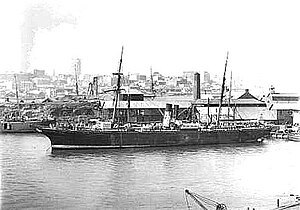SS City of Adelaide (1863)

| |
| History | |
|---|---|
| Name | SS City of Adelaide |
| Owner |
|
| Builder | J & G Thomson, Govan |
| Yard number | 67 |
| Launched | 22 December 1863 |
| Completed | 1864 |
| Out of service | 1912 |
| Fate |
|
| General characteristics | |
| Type | |
| Tonnage | |
| Length |
|
| Beam | 28.3 ft (8.6 m) |
| Draft | 16.6 ft (5.1 m) |
The City of Adelaide was a passenger steam ship launched during 1863 from Glasgow, Scotland. The vessel was later converted to a barque for use as a cargo transport. In 1912 the vessel was gutted by fire, and in 1916 the burnt hulk was run aground in Cockle Bay, Magnetic Island, Australia. During the Second World War four people were killed in a training accident when a RAAF aircraft struck the masts of the vessel.
History[]
Launched on 22 December 1863, the SS City of Adelaide was commissioned for the Australasian Steam Navigation Company and built in Govan, Glasgow by J & G Thomson.[1] The vessel ran regular passenger services between several destinations including Melbourne, Sydney,[2] Honolulu and San Francisco. Having undergone a refit in 1871 the vessel operated for a further 14 years before being retired from service in 1885. Following the merger of the Australasian Steam Navigation Company with the Queensland Steam Shipping Company, in 1887, City of Adelaide continued in service with the successor company Australasian United Steam Navigation Company.
She was sold in 1890 to W. A. Ritchie, of Sydney,[1] and was converted to a four masted barque by removing her boilers and engines.[3] In 1895 she was sold onto G J Robertson of Sydney.[1] In 1902 the vessel was purchased by Howard Smith Company of Townsville and used as a hulk for the storage of coal. In 1912 the vessel caught fire and burnt for a number of days before flames could be extinguished.[3] The burnt hulk of the vessel was then purchased in 1915, by George Butler, the son of the first European resident of Magnetic Island. Butler had the hull stripped, and an attempt was made to float the vessel to Magnetic Island’s Picnic Bay, where she would be scuttled to provide a breakwater for a jetty. However, as the vessel was being towed from Townsville to Picnic Bay she ran aground off Magnetic Island’s Cockle Bay.[3][4]
During World War II the wreck of the vessel was used as a target by Royal Australian Air Force (RAAF) bomber pilots from the nearby Garbutt Airfield. On 22 October 1942, six RAAF Bristol Beaufort bombers of 100 Squadron were participating in a coordinated mock torpedo attack on Townsville Harbour followed by a coordinated practice bombing of the wreck. Following a successful mock attack on Townsville Harbour, the six bombers climbed to approximately 305 metres (334 yd) and proceeded in a vee formation towards Cockle Bay. Several of the aircraft dived upon the wreck in a bombing run, during which one of the aircraft appeared to strike one of the masts of the sunken vessel, before crashing into the shallow ocean waters approximately 700 metres (770 yd) from the vessel. The plane’s fuselage disintegrated on impact instantly killing three RAAF officers and a United States Navy officer aboard the bomber.[5]

On 24 December 1971, Cyclone Althea struck the coast of northern Queensland near Magnetic Island, causing the partial collapse of part of the wreck’s iron hull. The sunken hull of the vessel has become an artificial island hosting a variety of plant and bird life approximately 300 metres (330 yd) off the shore of Cockle Bay. The location of the wreck is 19°10′29″S 146°49′32″E / 19.174842°S 146.825471°ECoordinates: 19°10′29″S 146°49′32″E / 19.174842°S 146.825471°E.
References[]
- ^ a b c "ss CITY OF ADELAIDE built by J & G Thomson Govan". Clydebuilt Ships Database. Archived from the original on 20 March 2012. Retrieved 6 January 2010.CS1 maint: unfit URL (link)
- ^ "A list of crew and Passengers arrived in the Steam Ship SS City of Adelaide..." State Records Authority of New South Wales. Archived from the original on 1 April 2011. Retrieved 6 January 2010.
- ^ a b c "Magnetic Island: a walk on the muddy side". Magnetic Times. Archived from the original on 8 April 2011. Retrieved 6 January 2010.
- ^ "Encyclopedia of Australian Shipwrecks - Queensland". Encyclopedia of Australian Shipwrecks. Archived from the original on 2 October 2009. Retrieved 6 January 2010.
- ^ "22 October 1942, Crash of a Beaufort Bomber, Cockle Bay, Magnetic Island". Peter Dunn's Australia at War. Archived from the original on 22 October 2009. Retrieved 6 January 2010.
- Ships built on the River Clyde
- 1863 ships
- Ship fires
- Maritime incidents in 1912
- Maritime incidents in 1915
- Coal hulks
- 1912 in Australia
- 1915 in Australia
- 1971 in Australia
- 1871–1900 ships of Australia
- 1901 – World War I ships of Australia
- Merchant ships of Australia
- Passenger ships of Australia
- Iron and steel steamships of Australia
- Barques of Australia
- Shipwrecks of Magnetic Island
 WikiMiniAtlas
WikiMiniAtlas